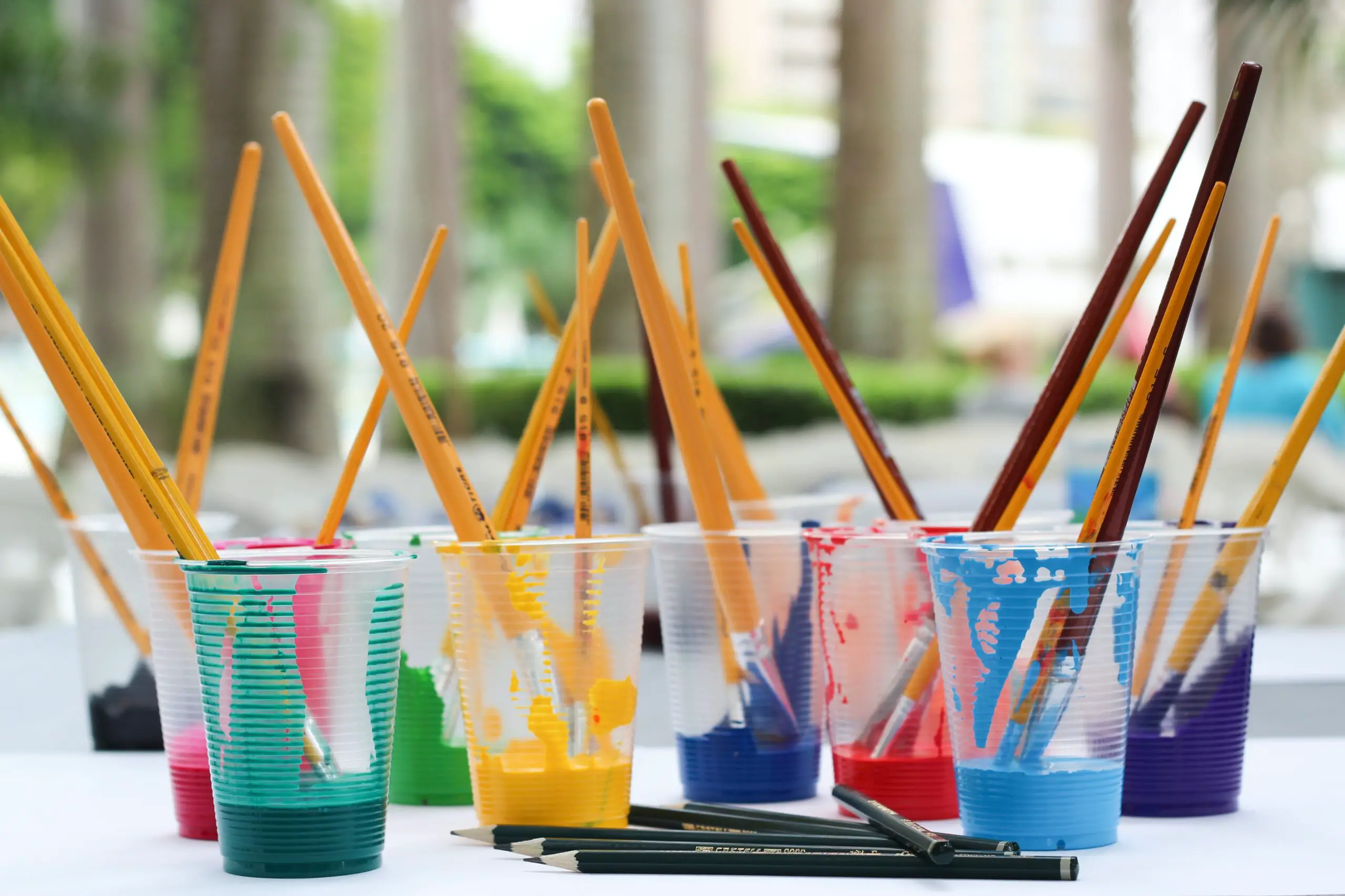Once you started using acrylic paint, one of the first questions that may come to mind is whether to mix water with it or not. I will be answering that question in this article using my own experience as well as the experiments done by acrylic paint manufacturers.
In general, acrylic paint can be thinned with water to get the desired consistency and for smoother application. The safe limit is 1:10, acrylic paint-to-water thinning ratio. Although adhesion is not affected, the acrylic paint may become water sensitive in high dilution.
You can even dilute acrylic paint in a 1:20 acrylic paint-to-water ratio in many acrylic paint colors except colors with high clay content or dye content. Also, thinned acrylic paints work best on porous surfaces rather than rigid smooth surfaces like glass.
Can you mix water with acrylic paint?
In general acrylic paint can be mixed with water safely up to 1 part paint to 10 parts water. Mixing water content can be changed depending on the consistency you need to achieve. Heavy-body acrylic paint usually needs thinning with water.
Acrylic paint is a water-based paint that contains around 45% – 55% of water. So clearly water is a central ingredient in acrylic paint and you can mix water with it. However water content may differ according to the consistency and quality of the paint.
Although you can mix acrylic paint with water it is not necessary. You can always use acrylic mediums. This makes the paint film more stable, unlike water. Mix 1 part acrylic medium with 10 parts water and then mix it with acrylic paint thinned to any consistency. It eliminates the sensitivity of highly thinned acrylic paint films.
However, I always use water with acrylic paint. It helps me to get the right consistency, especially with thick heavy body paint. You can dilute artists’ grade paint more as they have high pigment concentration.
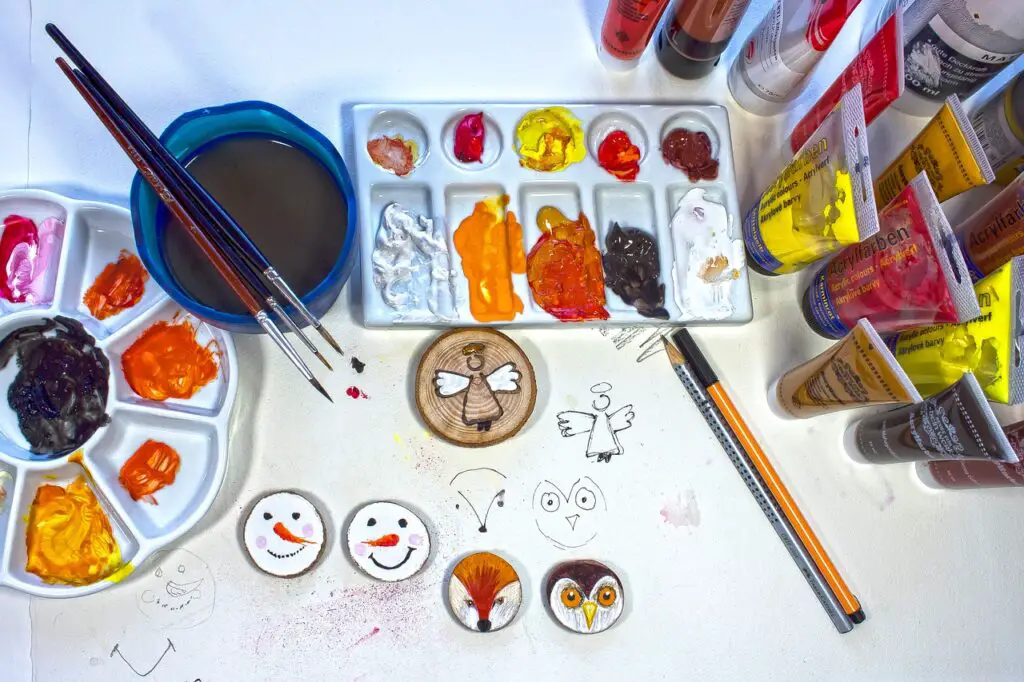
I also like to use paint and acrylic mediums only, in some cases. As an example, I like to use acrylic mediums for glazing as it gives me more control and transparent thin paint layers.
Student or craft-grade paints may contain more water and fillers as they are inexpensive ways of bulking acrylic paint. Artist-grade acrylic paint has the optimal water content and high pigment concentration (pigments give color to paint).
I have written a whole article about using acrylic paint directly on a surface. It will explain in detail if we can use acrylic paint straight out of the tube and if we need to prime a surface before using acrylic paint.
How much water do you mix with acrylic paint?
Acrylic paints can be safely thinned with 1 part paint to 10 parts water. If going for higher dilutions than the 1:20 ratio, mix 1 part acrylic medium with 10 parts water and dilute as needed. This will eliminate the water, acrylic medium, and varnish sensitivity and increase the paint film strength of extremely diluted acrylic paint.
These guidelines will not work in all cases. Therefore always make sure to test your application before going for the big art project. You can check the water sensitivity by rubbing the painted surface with a wet cotton swab or a piece of cloth. Make sure that you have primed the surface well.
In most cases just wetting the brush before painting is enough for the application. I do that most often when I need just smooth yet a thicker application. I have written a whole article about ‘wetting the brush before acrylic painting‘ if you need more information on this. You will also find different effects you can get by mixing with different amounts of water.
The safe limits of thinning acrylic paint
Golden Artist paints have done extensive experiments to see how much water can be safely added to acrylic paint. They have experimented on gesso-primed wood and aluminum panels. So these results will apply to absorbent surfaces. It is always best to test your application.
Adhesion is not affected in extremely thinned acrylic paint
In the experiment of Golden Paints, they have not experienced any adhesion issues even when thinned at 1 part paint to 100 parts water. I have also experienced this. You can read more on this in my article Do you have to wet the brush before acrylic painting?
Artists like Nancy Reyner are known to use very thin washes of acrylic paint. She even thins out acrylic paint up to 80% and has not experienced any adhesion issues. In the above article, you will see me using very thinned acrylic washes up to 80% thin without any issues. The Golden Paint experiment again proves that point.
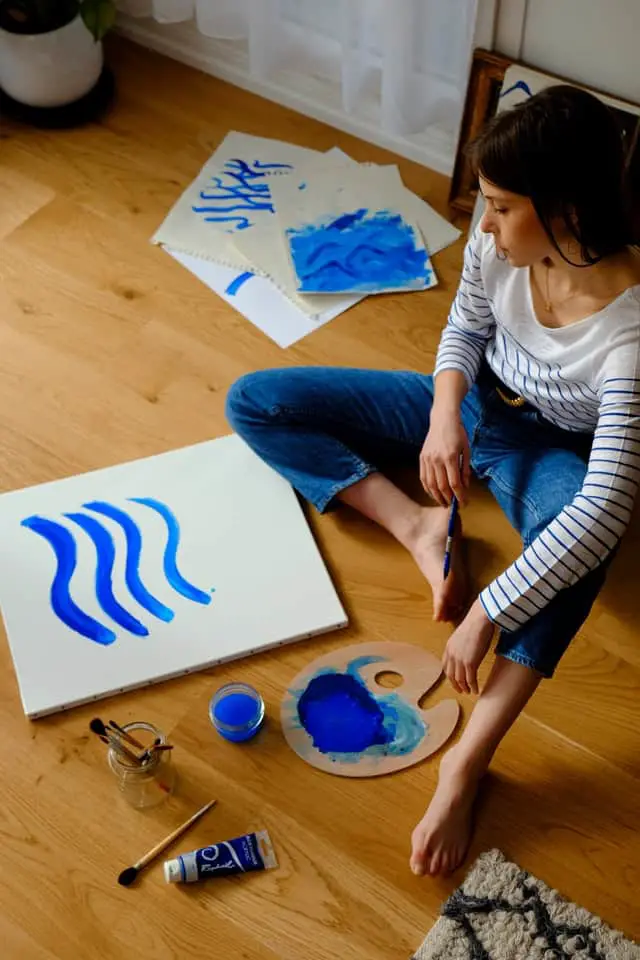
If you are painting on a nonabsorbent rigid surface like plastic, metal, glass, or glazed ceramics, you will need to take some extra steps to prepare them. These surfaces need to be sanded or sandblast first to provide a tooth for the primer-like gesso to adhere.
You can read my ‘painting guides’ to get a more detailed explanation of painting on these rigid smooth surfaces. You can check the surface adhesion by following the adhesion test.
I have written an article about ‘what surfaces acrylic paint not stick to?’. You can find more information on how to do the Cross Hatch Adhesion Test there. Make sure the painting surface is dry for at least 24 hours or a week, before checking adhesion. The more time you let acrylic paint cure, the better the adhesion would be.
Thin acrylic paints are sensitive to water
Sensitivity to water means the ability to use water to remove dry acrylic paint. This is where the problems can happen. Even if you did not thin acrylic paint to its extremes, the paint can be water sensitive and peel off when contacted with water after drying.
You can test the water sensitivity by rubbing dried acrylic paint with a damp cotton swab, or a damp piece of cloth. The sensitivity can be tested after 24 hours and a week of drying acrylic paint.
In the article ‘What will acrylic paint not stick to (experiment results)‘, I let acrylic paint dry for 8 days on gesso primed canvas. But the paint peeled off after contact with water and scrubbing. This might be because of the student-grade acrylic paint I have used.
In the Golden Paint experiment, they did not experience any sensitivity to the water of acrylic paints when thinned with 20 parts water. The problems arrived when thinning in 20 and 100 parts water with clay containing colors like raw umber and dye-like colors such as Anthraquinone Blue.
As you can see paint quality matters when it comes to water sensitivity. Also, the water sensitivity might be improved if acrylic paint is cured for more than 8 days. However, if you want a very archival-quality painting with the least water sensitivity, it is always best to go for a high-quality artist-grade brand like Golden Acrylic paint or Liquitex Acrylic paint.
If you want a relatively cheaper but good-quality acrylic paint brand you can try Liquitex Basics. I have reviewed and covered many aspects of Liquitex Basics in my review of it.
Thin acrylic paints are sensitive to other acrylic products
Using acrylic mediums and polymer varnishes, directly on top of extremely thinned acrylic paint can cause color lift. This happens especially with water-sensitive colors like raw umber. Sensitivity to other acrylic products can be reduced by mixing with a blend of acrylic medium to paint in a 1:10 ratio.
Mix a blend of acrylic medium to water in a 1:10 ratio with acrylic paint that is thinned to any extent. Let the paint dry for 24 hours and then apply the acrylic medium, polymer varnish, or any other acrylic product you desire. Remember that the more time you let the paint dry, the lesser the sensitivity would be.
Mixing acrylic medium with water to eliminate water sensitivity
The water sensitivity of acrylic paint thinned with even 100 parts of water can be eliminated by mixing it with acrylic medium. This is the safe way to thin acrylic paint to any extent. Use a blend of 1 part acrylic medium to 10 parts water to thin acrylic paint as needed.
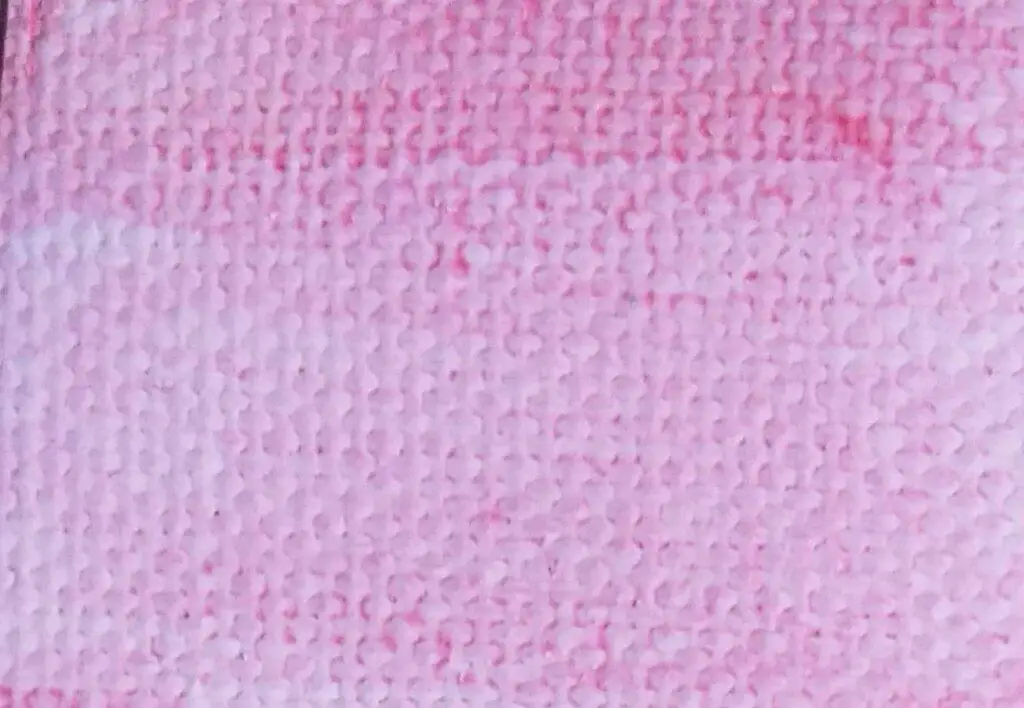
Some of the best acrylic mediums you can use are fluid matte medium, gloss medium, Golden GAC100, or high-flow mediums. Always test the application first before going big on your painting.
You can test the sensitivity with a damp cotton swab or a damp piece of cloth rubbed on the dry paint. Remember that the more you let the paint dry, the paint will become less sensitive to water.
Alternative to water and acrylic medium blend to reduce sensitivity…
If you do not like the idea of mixing with acrylic mediums, you can spray an isolation coat on thinned acrylic paint washes and then use an archival varnish. This can decrease the sensitivity to water, acrylic mediums, and varnishes of extremely thin acrylic paint wash.
Mixing acrylic paint with water for pouring
Acrylic pouring is another popular art technique apart from brush artwork. It requires pouring flowy acrylic paint onto the surface. Acrylic paint thinning can be done either with water or a pouring medium.
Different artists use different mixtures of water and pouring mediums. Let’s explore some of them below.
Mix paint to water at a 3:2 ratio if using only water
As a general acrylic pouring recipe mix water to paint in a 3:2 ratio. Use 80 g (2.82 oz) of water with 120g (4.24 oz) of white paint. Mix other colors of 40g (1.41 oz) with 60g (2.12 oz) of water. In this method, you will not need to mix with an acrylic pouring medium.
The reason why more white is mixed is that acrylic pours generally require more white paint as it creates the base of the acrylic pour.
Mix paint and water well. When using only water for paint pours make sure to get a good quality student-grade acrylic paint brand like Liquitex Basics, Winsor & Newton Galleria, or Amsterdam Standard. This ensures the stability of the paint film after drying.
Mix paint to medium at a 1:2 ratio if using mediums
The medium thickness of mixed paint is good for most acrylic pours. To achieve a medium thickness of paint mix the paint with the pouring medium in a 1:2 ratio. You can also check the manufactures guide on mixing ratios.
There are two important aspects to checking if the paint is of the right thickness. They are the trace and the mound. Trace is the line of paint that drips off the mixing stick when it is held two inches above the stick.
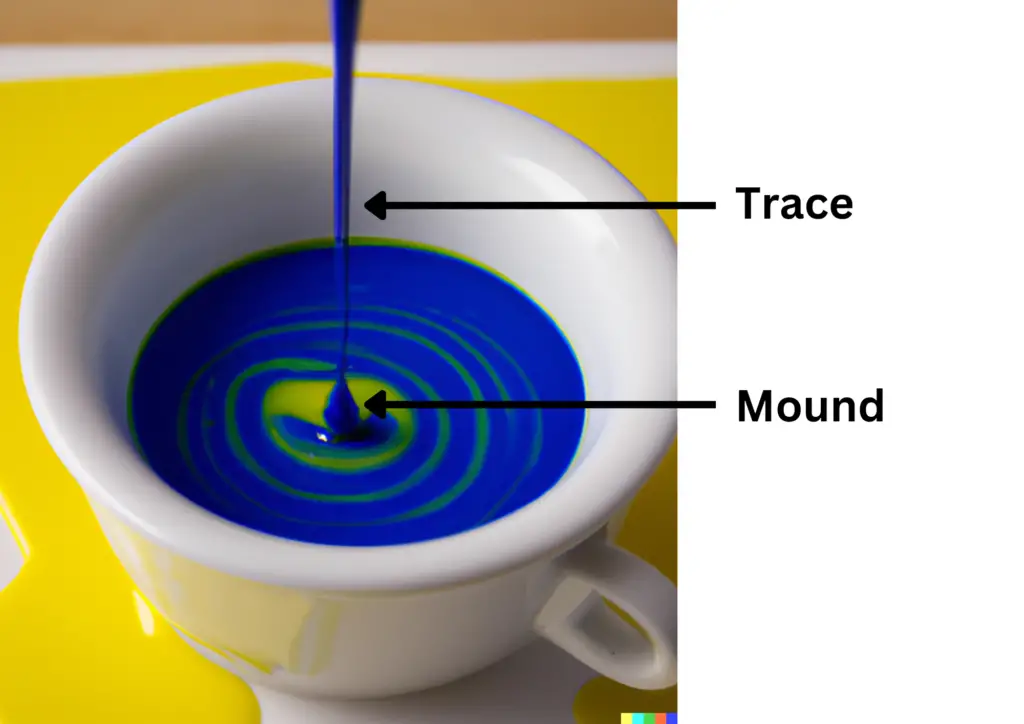
The trace line needs to be smooth and should not break in between. If there is any break of the line it is a sign of paint not mixing well and having chunks in the paint mix. Also, it is best to use a stick to mix rather than using a spoon.
Mounds are the folds of paint that are formed on the surface of the paint when dripping down the mixing stick when held two inches above the paint. Mixing well is an important step in acrylic pours. Check if the mound takes about one second to sink in the medium-thickness paint mixture.
If you want a thicker acrylic pour mixture you can mix acrylic paint to pour medium in a 2:3 ratio. Check if the mound takes slightly more than one second to sink. The trace should always drip in a line.
A thicker consistency is good for ring pours, swipes, and bloom pour techniques. You will need to use a spinner to spread the paint for thick consistency rather than tilting the surface. This consistency will give your sharper lines in the pour art.
You can make the paint in thin consistency by mixing 1:3 part of the paint to pour a medium. You will have a consistent trace with a small mound that immediately disappears in paint. You can do popular dutch pour, balloon pour, and pearl pour with this technique. You will get less crisp lines and have more movement of paint with thin consistency.
Conclusion
You can certainly mix water with acrylic paint as acrylic paint is water-based. You can safely thin acrylic paint with 1 part paint to 10 parts water. If you want to dilute colors above 1:20 dilution, use an acrylic medium blend with thin paint. This blend can be made by mixing 1 part acrylic medium with 10 parts water. Using an acrylic medium stabilizes the paint film as well.

